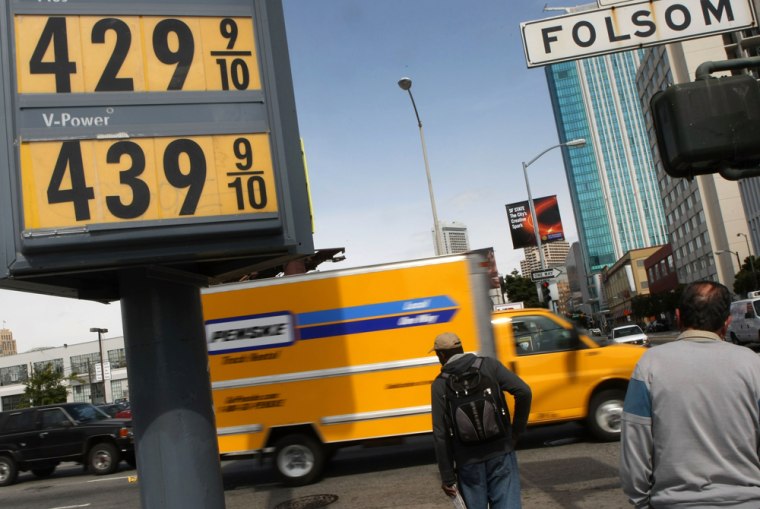For 20 years now, workers in Palm Beach County, Fla., have been counting cars with sensors at strategic points along the county's 4,000 miles of roads. And as sure as the tide flows in the nearby Atlantic, nearly every year traffic volume has climbed at least 2 percent. But in 2007 there was a slight decline in the number of vehicles on the roads. And this year, traffic is down 7.5 percent through March. "We're seeing a very significant change," says county engineer George Webb. "We're having a good time speculating why."
It's not just Palm Beach. Traffic levels are trending downward nationwide. Preliminary figures from the Federal Highway Administration show it falling 1.4 percent last year. Now, with nationwide gasoline prices having recently passed the inflation-adjusted record of $3.40 a gallon set back in 1981, the U.S. Energy Information Administration is predicting gas consumption will actually fall 0.3 percent this year. That would be the first annual decline since 1991. Others believe the falloff in consumption is actually steeper than the government's numbers show. "Our canaries out there tell us they are seeing demand drop much more considerably than the fraction the EIA is talking about," says Tom Kloza, chief oil analyst at Oil Price Information Service, a market research firm in Gaithersburg, Md.
Is oil-guzzling America changing its profligate ways? Some think so, though it's worth noting the U.S. still consumes one-third of the world's annual gasoline output. "It appears we've finally hit the ceiling that's causing the U.S. population to rethink how and where they use their vehicles," says Paul Weissgarber, who heads the energy practice at consulting firm A.T. Kearney.
Just look at the latest auto sales figures. Sales fell 8 percent overall during the first quarter of 2008, and those of gas-guzzling large SUVs and pickup trucks dropped off a cliff, down 27 percent and 14 percent, respectively. High gas prices are forcing even SUV lovers to shift gears. Fed up with spending $100 five times a month to fill up his Chevrolet Suburban, auto parts exec Ron Gesquere recently bid $10,000 on eBay for a used Mini Cooper S. "I could make the payments on the Mini with the savings in gas," says the suburban Detroit resident.
For years industry analysts were surprised that gasoline consumption continued to rise even as prices kept climbing. But now it looks as if some sort of psychological threshold has been breached. Fuel prices are rising faster than incomes, the war in Iraq has fanned concerns about U.S. oil dependency abroad, and a growing climate awareness has taken hold among consumers.
Consider, too, that ridership on public transport climbed to a 50-year high in 2007, reports the American Public Transportation Assn., thanks in part to the fact more companies are picking up at least part of the tab. And sales of more fuel-efficient cars are up. The shift has not been lost on Detroit's Big Three, which depend on SUVs and pickups for a big chunk of their profits. "Fuel economy as a selling point is absolutely here to stay," says James Farley, group vice-president of marketing and communications at Ford Motor. "Our future plans revolve around the idea that gasoline is going sideways and up from here, not down."
Demographic factors may also weigh on gasoline consumption. In the 1950s and '60s, when the postwar march to the suburbs was in full swing and the nation's highways were being built out, gas consumption grew by an average of 4 percent a year. In more recent years, that rate has moderated to 1.2 percent. A study released in April by the EIA posited that part of the decline could be attributed to falling population growth and baby boomers exiting their peak driving years. That translates into fewer car sales. "What we were seeing is the automobile market is saturated," says Tancred Lidderdale, senior economist with the EIA. "Even as income continues to grow, we're not going to see the number of cars increase any further."
Mind you, it's not yet certain that falling gas consumption is a trend that's here to stay. Historically, consumption tends to dip during recessions, then rebounds after. "There have really only been a few times Americans have cut back their gas consumption over a long period of time," says Geoff Sundstrom, a spokesperson for AAA. "Those occasions are where you've had high prices and a recession, such as 1974 and 1981. It looks like we're heading into another one of those." In fact, the EIA's researchers expect that consumption growth will rise back up to 0.9 percent next year — though that's still below the 1.2 percent we've averaged so far this decade. Many analysts have been knocking down their estimates of worldwide oil demand growth, due in large part to weaker consumption in the U.S.
So even if gas consumption does bounce back, it's likely to do so at a much slower pace. "Consumer habits are pretty sticky," says Adam Robinson, an energy analyst at Lehman Brothers. "We've seen a long period of high prices that has finally hit the consumer, and now they're going to shift their preferences."
Indeed, some commuters are surprised at how easily public transport can become habit-forming. Aly Cohen, a 27-year-old financial analyst at Costco Wholesale, first tried taking the bus to work in January after her car got stuck in the snow. Now, with her employer picking up most of the $63 tab for a monthly bus pass, she has stopped driving to work altogether and cut her gas consumption in half. "It's nice," she says. "I can take a nap or read." If copied on a large scale, such shifts in commuting habits may change the energy consumption game in the U.S.
